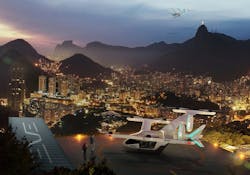Flying cabs steal thunder at air show as clean future beckons
SINGAPORE - Electric flying taxis took center stage at the Singapore Airshow last week as pressure to cut emissions and rebound from the pandemic leads airlines to invest in short, battery-powered hops to spur future growth, Kyunghee Park, Siddharth Philip and Anurag Kotoky report for Bloomberg. Continue reading original article.
The Military & Aerospace Electronics take:
23 Feb. 2022 - Bloomberg reports that 82,500 passenger eVTOLs - aircraft that are electric and capable of vertical takeoffs and landings - are expected to be in operation by 2050.
The aircraft, which the industry aims to utilize as autonomous, remotely piloted, or piloted, can be used on short jaunts across the city, airport-to-airport shuttles, or for sightseeing, are in high demand.
While there are currently more than 200 eVTOL designs or concepts released, the Federal Aviation Administration (FAA) and other global regulators have yet to be certified.
Beyond the utility of eVTOLs, many airlines and the aircraft industry aim to lower carbon emissions through electric and hybrid-electric technology.
“Decarbonization is the world’s single biggest challenge we face as a generation, and the decarbonization of aviation is the single biggest opportunity us in the aviation industry have,” said Domhnal Slattery, chief executive officer of Avolon Holdings, an aircraft leasing company. “The electrification of aircraft is a first and important step in that journey.”
Related: Eve Urban Air Mobility and Helisul Aviation announce UAM partnership
Related: Honeywell and Jaunt Air Mobility collaborate on urban air mobility technology
Related: Urban Air Mobility already has 200 eVTOL designs
Jamie Whitney, Associate Editor
Intelligent Aerospace
